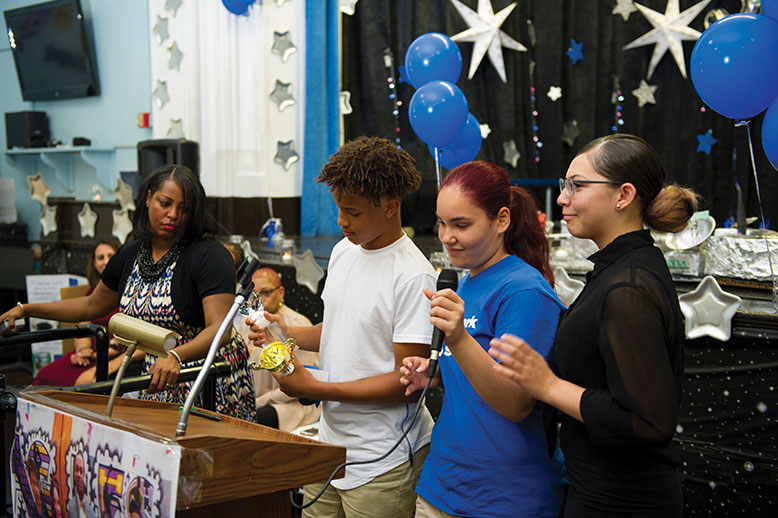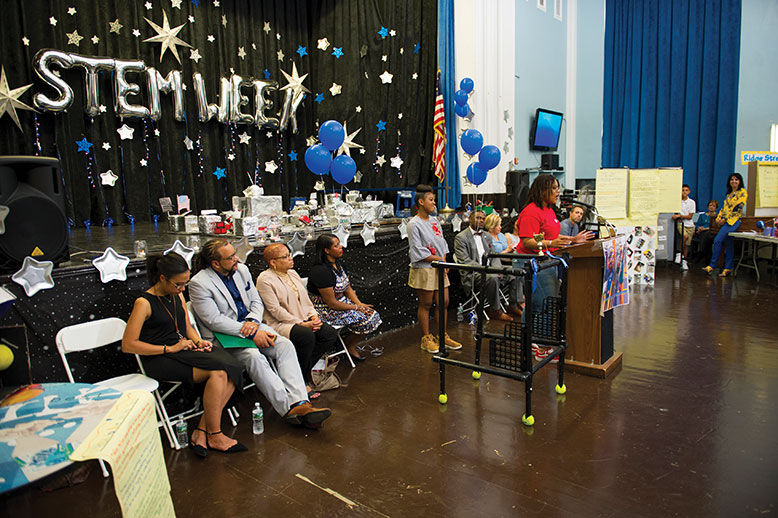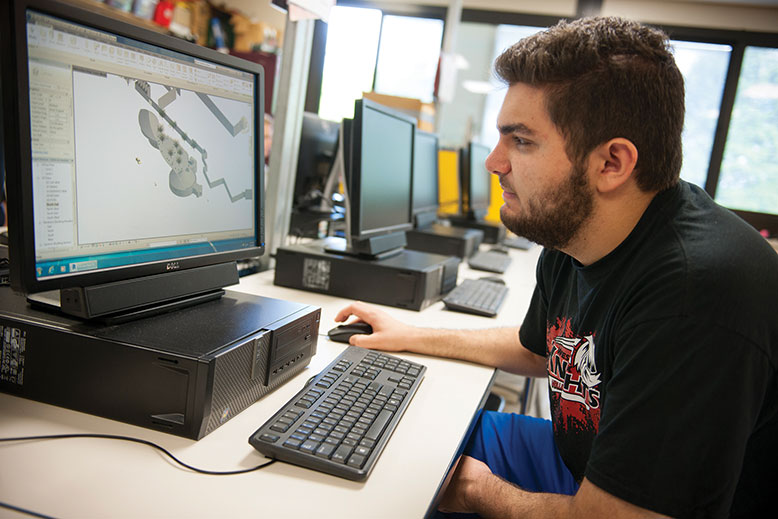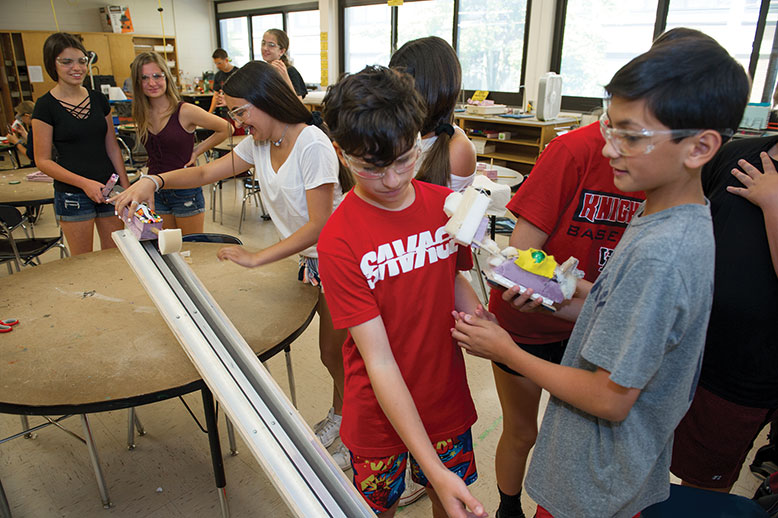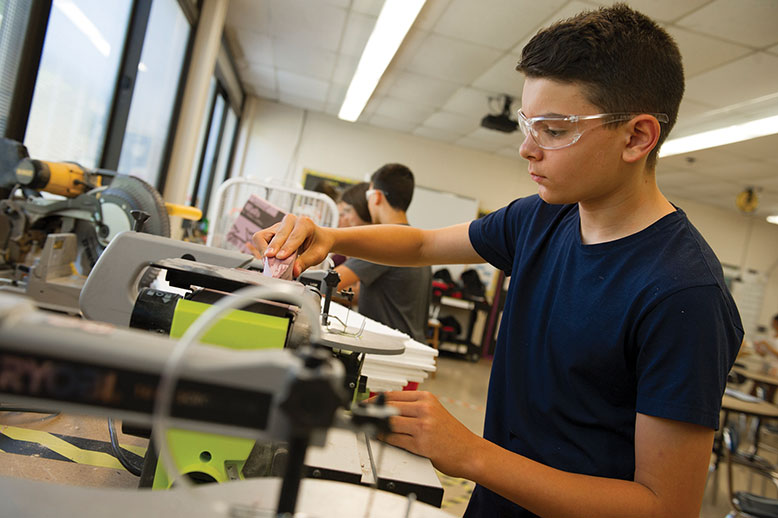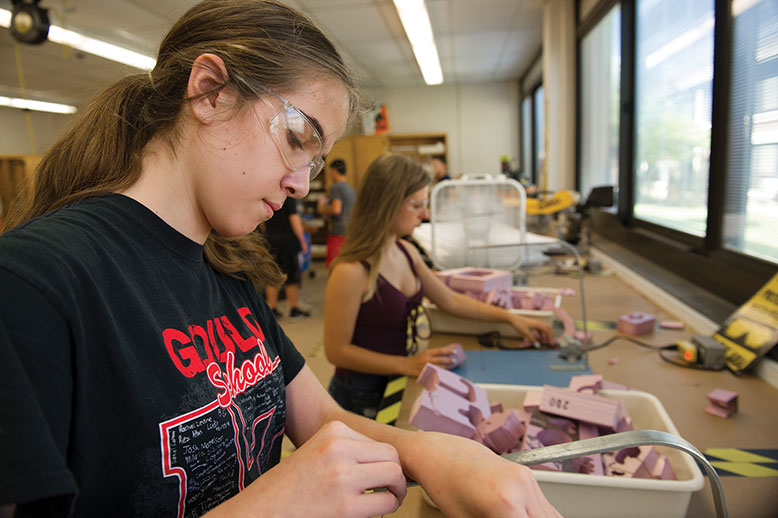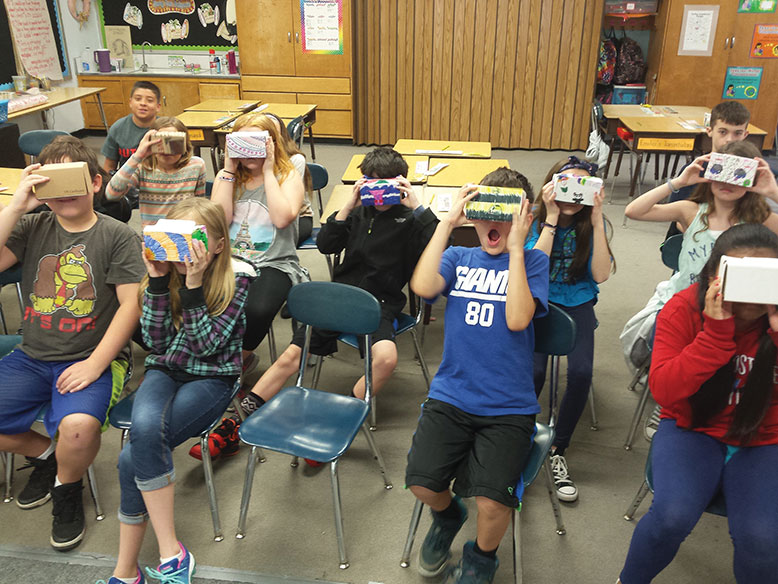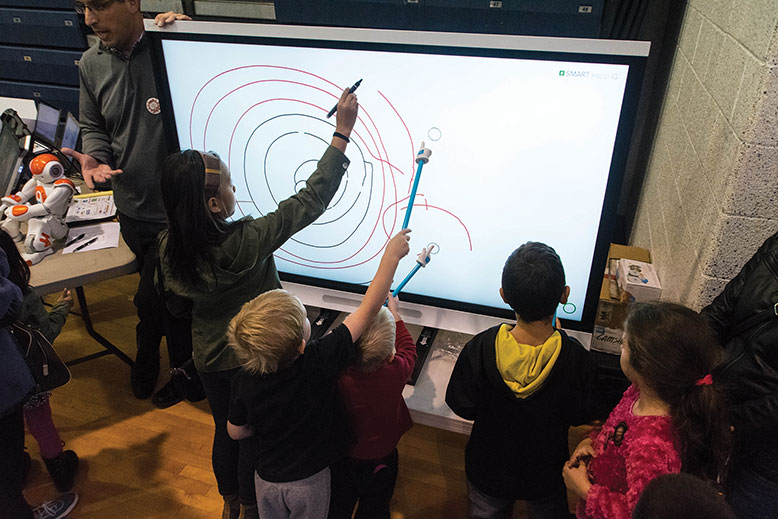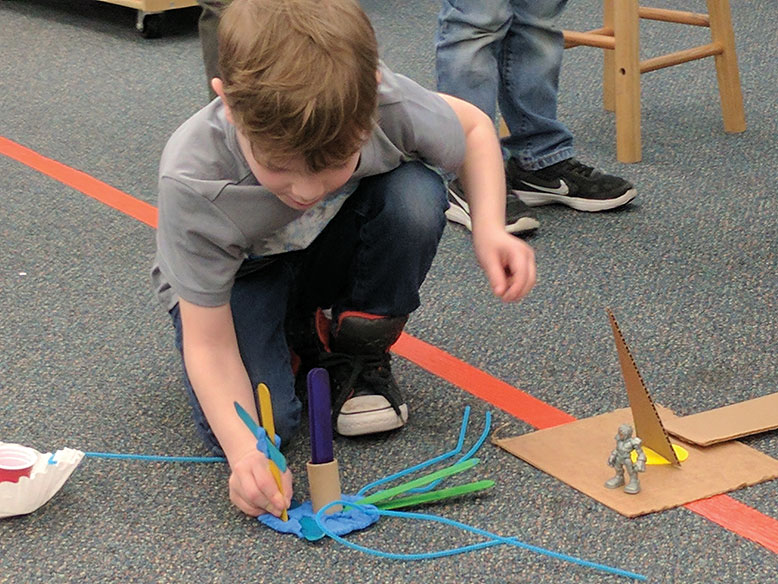
“I want to be the first Dominican astronaut.”
Jhosue Rubio, an eighth-grader in Newark’s Ridge Street School, is standing behind the invention that earned his team the top prize for middle-schoolers in the city’s STEM Fair. It’s the culmination of Newark’s second annual STEM Week, a hands-on engineering-based curriculum aimed at getting middle-schoolers excited about science. This is Rubio’s second year participating in the event, which has helped fuel his dreams of a career in science that may or may not include a walk on the moon.
On this final day of the program, he and two of his partners on the project, Siobhan Rousselle and Gloria Perez (a fourth team member, Daniel Alvarez, is absent), are eager to demonstrate the solar-powered disability walker they created, largely with PVC piping and ingenuity. They admit it’s a work in progress, but that’s an essential part of the STEM approach: the notion that making mistakes, and fixing them, is intrinsic to the scientific method.
Ultimately, they’d like to find someone to help them with production and distribution of the walker, which doubles as a solar charger and can be adjusted to 10 different heights. “It’s more than just a project,” notes Rouselle. “This is something we can help the world with.”
That’s precisely the attitude that programs like STEM Week were designed to kindle. And it can’t happen quickly enough. Across the country, there are some 3 million more open jobs in STEM (the acronym stands for science, technology, engineering and math) fields than there are trained professionals to fill them. In New Jersey alone, there are 1.4 unfilled STEM positions for every unemployed worker. In coming decades, jobs in STEM are expected to grow at twice the rate of other positions. Yet as a country, and a state, we remain vastly unprepared to fill them.
Consider that, on the 2015 Programme for International Student Assessment, a series of cross-national tests measuring proficiency in a variety of subjects, the U.S. ranked 24th out of 71 nations in science and 38th in math. And student engagement in science, according to a report from the testing service ACT, remained flat from 2012 to 2017, with just under 50 percent of students expressing interest in STEM.
One probable cause of our lag in STEM is a lack of qualified teachers. Given that STEM professionals can earn significantly more working in the STEM fields than teaching those subjects, it’s hard for schools to recruit the best candidates. And many experts believe that our teaching methods are woefully out of date. A 2017 report issued by the educational advocacy organization JerseyCAN noted that “our current education system was built for an industrialized age of standardization. In our globally connected and fast-changing world, we need to free the education system to innovate.”
That’s beginning to happen in New Jersey—albeit in fits and starts, and more robustly in communities with abundant resources than in those struggling just to maintain the status quo. Throughout the state, school districts and teachers’ colleges, as well as the Department of Education and the Legislature, are responding to a changing job market and a globalized economy in which innovation in science and technology plays an increasingly critical role. In fact, their response may mark the beginnings of a sea change not just in the way we teach science, but in our approach to education overall. The Legislature, for example, mandated this year that every public high school in New Jersey offer at least one class in computer science.
STEM: The Course
The acronym STEM (successor to the less than euphonious SMET) was coined some three decades ago to describe the growing ascendance of science, mathematics, engineering and technology in our culture and economy. But until recently, when educators spoke about a class in STEM, they generally meant a course in one of the individual STEM disciplines (like biology, physics or math). Today, however, a growing number of schools are offering classes, often called STEM or Introduction to STEM, that combine the disciplines in a way that earlier science classes rarely, if ever, did.
What drives most STEM classes is an emphasis on solving real-world problems through collaboration, research and creative thinking, often drawing on the engineering design process, a series of steps used by engineers to develop products. In the most recent academic year, for instance, all of Newark’s 38 public middle schools implemented a program called IQWST (Investigating and Questioning Our World Through Science and Technology). Developed by a consortium of universities, the program challenges students to use their knowledge across various scientific disciplines to tackle a series of problems, from the creation of an effective soap to racing, jumping and crawling across the classroom to measure the properties of motion.
Often aimed at middle-schoolers, STEM classes are designed to get students excited about science in general and help them identify areas of science in which they may have a particular interest. Barbara Longo, superintendent of the West Essex Regional School District, notes that students now taking STEM in the district say “it’s opened their eyes to some of the different courses they’ll want to take when they get to high school, which they didn’t know about before.”
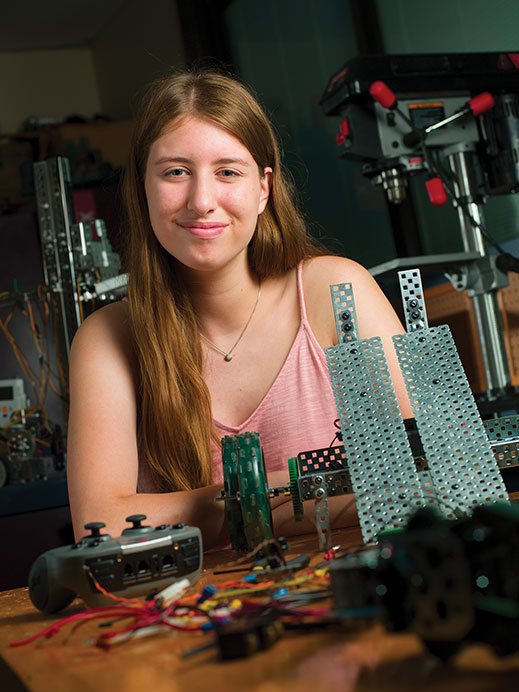
Jessica Wiederhorn has her robot at the ready for an 11th grade in-class competition at West Essex Regional High School. Photo by John Emerson
Problem-Based Learning
The same kind of problem-based learning (PBL) that informs STEM classes is at the heart of a new approach to teaching science at every level. Essentially, in PBL, students are offered a series of open-ended questions, or prompts, and have to respond by identifying a problem—how to build a bridge that withstands environmental pressures, for example, or find a way to push materials across a barrier—and arriving at, and physically creating, one of several potential solutions. Lecture and note-taking time is at a minimum, and often students have to research the science on their own in order to understand the problem and/or its solution. As in a typical STEM class, students generally work in small groups to brainstorm ideas.
PBL tends to engage students in a way that lectures rarely do. “When you’re connected to what’s going on, that’s when it makes sense to you,” says Elizabeth Ricafort, supervisor of science for the West Essex schools. “And that learning process doesn’t happen fully if you’re just sitting there taking notes or doing a math problem.” Jessica Wiederhorn, who’s going into her senior year at West Essex Regional High School and plans to study engineering in college, agrees. “I definitely remember the projects I’ve done a lot more than the lectures I’ve sat through. Applying the concepts you’ve been learning gives you a deeper understanding of them.”
PBL also teaches students the skills that are most in demand by today’s employers, sometimes known as the “four Cs”: collaboration, critical thinking, communication and creativity. And perhaps most important, PBL teaches that failure isn’t the end of a project but a new beginning. Wiederhorn and her group were charged with building a robot with a claw that could pick up balls and move them across a barrier, where another group of students was poised to move the balls back; the group that succeeded in moving the greatest number of balls across the barrier would win the competition. When Wiederhorn’s team discovered that the claw wasn’t working as well as they’d hoped, they replaced it with a kind of robot bulldozer, thinking like the engineers some of them hope to be.
One key element of PBL is that it allows students to be leaders in their own education. To someone brought up in a traditional teacher-centric system, that might sound like a recipe for chaos, but Ross Kasun, superintendent of the Freehold Township school district, believes it’s essential to teaching science—and other subjects—in the 21st century. “It offers the skill sets our students are going to need to live happy, successful lives, to secure careers—and multiple careers at that—and to be entrepreneurs, as freelance is becoming more and more prevalent,” he says. In one of Freehold’s middle school personal-financial literacy classes, for instance, a student realized that his parents spent a great deal of time and gas money driving him and his siblings from one activity to another. So he came up with an idea for an app that would allow parents to communicate with one another to pool driving resources. “He had the autonomy,” Kasun notes, “to pick a problem, build an action plan, do some research, and then utilize the resources we provide to create a solution.”
Integrated STEM
To reflect the collaborative nature of today’s science, a growing number of educators support an approach known as integrated STEM, or iSTEM. “Many of the problems that we face, from climate change to space exploration, require an interdisciplinary approach,” says David Shernoff, director of the Rutgers Center for Mathematics, Science, and Computer Education (CMSCE), noting that the Next Generation Science Standards “are very suggestive of more integrative approaches.”
A collaborative effort among a number of states, including New Jersey, the standards are, in the words of the team that created them “arranged in a coherent manner across disciplines.” Recently, the New Jersey Department of Education worked with the College of New Jersey to create a hands-on science curriculum emphasizing the interrelationships of the STEM disciplines. The DOE, says Linda Eno, the department’s assistant commissioner for academics, “is committed to promoting an interdisciplinary approach to the teaching of STEM.”
Schools are starting to get the message. Over the last several years, the West Essex school district has ramped up its iSTEM efforts. Lisa Swanick, the district’s supervisor of arts, explains that “all of our subject areas are integrated. Whether it’s math, science, engineering, English or arts, we’re really looking at taking every experience that we’re giving them here and allowing them to make connections.”
Teachers frequently work together to create cross-curricular projects, which draw on knowledge and skills from a variety of disciplines—anatomy and computer-assisted design, say. Ready for more acronyms? Among the latest in this conversation are STEAM (science, technology, engineering, art, and math) and STREAM (the R is for reading).
Makerspaces
There may be no better representation of STEAM than in the concept of makerspaces. Though they vary widely in size and resources—some exist in large, dedicated rooms, others in a section of a space like a library, and still others on rolling carts—all makerspaces offer students a chance, in the words of Marc Natanagara, assistant superintendent for the Toms River Regional School District, “to attack challenges with imagination, creative uses of tools and materials, and often, reckless abandon.”
In some schools, makerspaces are used in conjunction with the curriculum; in others, they’re places where students can use their hands to create whatever comes to mind, from a robot to a 3-D painting. Depending on needs and budgets, materials range from cardboard tubes to Lego robot-building Mindstorm kits to 3-D printers. The spaces, which are in all 18 schools in the Toms River district, encourage what Natanagara calls “a maker mindset.”
“Students,” says Natanagara, “need a place where they can express themselves, explore and problem-solve in an environment where the teacher just acts as facilitator rather than as problem-giver or problem-solver.”
Challenges Ahead
Few educators believe that such a radical shift in our approach to STEM education (and perhaps to education in general) will be easy. Schools face serious challenges to implementation, not the least of which is financial. From makerspaces to middle school STEM classes, innovations require an investment in materials and professional development; some necessitate the purchase of specialized furniture or the renovation of existing school buildings to facilitate collaboration, experimentation and hands-on learning.
Schools in affluent communities, says Lauren Bound, supervisor of curriculum and instruction in mathematics, science and technology in the Kenilworth school district, are supported by generous budgets, well-funded PTOs and local foundations. More economically challenged districts have to scramble for funds. Grants and partnerships with corporate neighbors can help—Kenilworth, for instance, has a profitable partnership with nearby Merck, which enables them to offer Students 2 Science, a program in which students perform hands-on experiments while teleconferencing with a working scientist.
The state may be able to fill some gaps. To help pay for those mandated computer science courses, for example, Governor Phil Murphy set aside $2 million in his proposed education budget. But even with grants, partnerships and state assistance, change is going to be easier for some districts than others.
Another impediment to change is standardized testing, which has put pressure on districts to teach to the test—emphasizing the memorization of facts and formulas over the cultivation of creative and innovative thinking. But districts like West Essex that have implemented more integrative and problem-based approaches to STEM are finding that, for the most part, students are learning the concepts they need to do well on tests like the statewide PARCC math exam, the fourth- and eighth-grade NJASK assessments, and the 11th-grade Biology Competency Test. “When students are engaged in these problems,” says Danielle Purciello, who teaches eighth-grade physical science at West Essex Regional Middle School, “they’re learning the content as they go and applying it, which is way beyond knowing a definition.”
An equally serious challenge is the search for qualified teachers. Consider that, in spite of the fact that the state boasts two dozen teacher-education programs, in some recent years those programs have produced as few as nine physics teachers and 16 chemistry teachers. Turning out teachers has always been difficult in the STEM disciplines, which promise salaries to those working in the corporate and research sectors far higher than they’d likely receive as K-to-12 educators.
New Jersey’s institutions of higher education are starting to rise to the challenge. The College of New Jersey’s Center for Excellence in STEM Education, for instance, has offered professional development to teachers in integrative STEM for nearly seven years and is reaching out to teachers seeking development in computer science education; the college’s School of Engineering also offers a master’s degree in integrative STEM education. “Very few teachers understand how to teach iSTEM well,” says Steve O’Brien, the center’s director. That’s “unfortunate,” he adds, “because it’s a way to engage students in a broad set of cognitive abilities.”
New Jersey Institute of Technology also offers professional development in STEM curriculum, and Linda Hirsch, assistant director of research, evaluation and program outreach for NJIT’s Center for Pre-College Programs, notes that teachers who’ve participated tend to come away with a sense of excitement and possibility. In fact, says Dawna Schultz, director of CMSCE’s in-district initiatives, STEM teachers in general are often “the most creative educators—highly motivated and hungry for new ideas.” Unfortunately, says Hirsch, these teachers “don’t always get enough support from their administrations or enough money to buy the new books and supplies they need.”
Perhaps the greatest challenge in STEM education is ensuring that minorities and girls don’t miss out on the STEM revolution and the jobs and socioeconomic advancement it promises. On the most recent National Assessment of Educational Progress (NAEP), 56 percent of white eighth-graders scored at or above proficient in technical and engineering literacy, compared to 18 percent of black eighth-graders. Girls did slightly better than boys, with 45 percent meeting or exceeding the proficiency level compared to 42 percent of boys. The numbers after high school graduation present a starker reality: While women represent roughly half of the U.S. workforce, they hold only 26 percent of STEM positions; minorities represent 27 percent of the workforce, but hold only 11 percent of all STEM jobs.
To rectify these discrepancies, public and private organizations across the state are working to ensure that girls and minorities are engaged in STEM early and are exposed to STEM professionals who look like them. The Center for Pre College at NJIT offers a program for urban students in the elementary grades “to get them onto a college campus, help them with math, and show them that going into a STEM career is going to give them a better life than some of the other choices they might make,” says Hirsch. Rutgers Cooperative Extension offers a similar opportunity, the 4-H STEM Ambassador Program Summer Science Program, for high school students.
Programs aimed specifically at girls include NJIT’s FEMME, which engages girls in STEM and succeeds at infusing them with confidence, says Hirsch, because it’s female only. And the national nonprofit Girls Who Code offers free clubs (Around 30 of them in the Garden State) to girls in grades 3-5 and grades 6-12, as well as free summer immersion programs for girls in grades 10-11 in urban areas like Newark and Jersey City.
Today, opportunities to promote STEM in the state are abundant but less than unified. Patricia Morgan, executive director of JerseyCAN, lauds the Department of Education for its promising Future Ready Schools initiative, which is working to provide school districts with the framework necessary to promote digital education, as well as for its Office of Educational Technology and School Innovation and Office of Career Readiness. But ultimately, she says, “we need a clear vision from the Department of Education on a statewide approach to STEM that will help every district feel like they’re doing what they should be—meaning a comprehensive, statewide plan for STEM education and a designated staff member working to implement that plan.”
There may be reason for hope. According to Michael Yaple, director of public information at the DOE, “there are various efforts under way at the department to advance the governor’s and the commissioner’s vision, and STEM is absolutely among those priorities.” That’s crucial, Morgan notes, because, through STEM education, “we’re trying to create a pipeline of folks that are going to change the world.”
Leslie Garisto Pfaff is a longtime contributor specializing in education and health.

